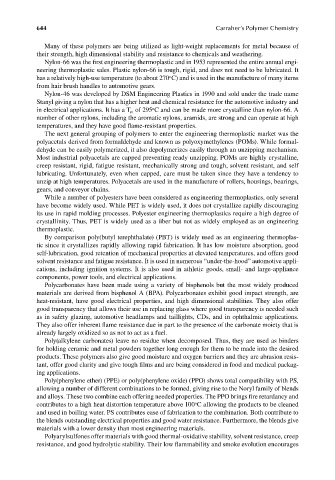Page 681 - Carrahers_Polymer_Chemistry,_Eighth_Edition
P. 681
644 Carraher’s Polymer Chemistry
Many of these polymers are being utilized as light-weight replacements for metal because of
their strength, high dimensional stability and resistance to chemicals and weathering.
Nylon-66 was the first engineering thermoplastic and in 1953 represented the entire annual engi-
neering thermoplastic sales. Plastic nylon-66 is tough, rigid, and does not need to be lubricated. It
o
has a relatively high-use temperature (to about 270 C) and is used in the manufacture of many items
from hair brush handles to automotive gears.
Nylon-46 was developed by DSM Engineering Plastics in 1990 and sold under the trade name
Stanyl giving a nylon that has a higher heat and chemical resistance for the automotive industry and
o
in electrical applications. It has a T of 295 C and can be made more crystalline than nylon-66. A
m
number of other nylons, including the aromatic nylons, aramids, are strong and can operate at high
temperatures, and they have good fl ame-resistant properties.
The next general grouping of polymers to enter the engineering thermoplastic market was the
polyacetals derived from formaldehyde and known as polyoxymethylenes (POMs). While formal-
dehyde can be easily polymerized, it also depolymerizes easily through an unzipping mechanism.
Most industrial polyacetals are capped preventing ready unzipping. POMs are highly crystalline,
creep resistant, rigid, fatigue resistant, mechanically strong and tough, solvent resistant, and self
lubricating. Unfortunately, even when capped, care must be taken since they have a tendency to
unzip at high temperatures. Polyacetals are used in the manufacture of rollers, housings, bearings,
gears, and conveyor chains.
While a number of polyesters have been considered as engineering thermoplastics, only several
have become widely used. While PET is widely used, it does not crystallize rapidly discouraging
its use in rapid molding processes. Polyester engineering thermoplastics require a high degree of
crystallinity. Thus, PET is widely used as a fiber but not as widely employed as an engineering
thermoplastic.
By comparison poly(butyl terephthalate) (PBT) is widely used as an engineering thermoplas-
tic since it crystallizes rapidly allowing rapid fabrication. It has low moisture absorption, good
self-lubrication, good retention of mechanical properties at elevated temperatures, and offers good
solvent resistance and fatigue resistance. It is used in numerous “under-the-hood” automotive appli-
cations, including ignition systems. It is also used in athletic goods, small- and large-appliance
components, power tools, and electrical applications.
Polycarbonates have been made using a variety of bisphenols but the most widely produced
materials are derived from bisphenol A (BPA). Polycarbonates exhibit good impact strength, are
heat-resistant, have good electrical properties, and high dimensional stabilities. They also offer
good transparency that allows their use in replacing glass where good transparency is needed such
as in safety glazing, automotive headlamps and taillights, CDs, and in ophthalmic applications.
They also offer inherent flame resistance due in part to the presence of the carbonate moiety that is
already largely oxidized so as not to act as a fuel.
Poly(alkylene carbonates) leave no residue when decomposed. Thus, they are used as binders
for holding ceramic and metal powders together long enough for them to be made into the desired
products. These polymers also give good moisture and oxygen barriers and they are abrasion resis-
tant, offer good clarity and give tough films and are being considered in food and medical packag-
ing applications.
Poly(phenylene ether) (PPE) or poly(phenylene oxide) (PPO) shows total compatibility with PS,
allowing a number of different combinations to be formed, giving rise to the Noryl family of blends
and alloys. These two combine each offering needed properties. The PPO brings fire retardancy and
o
contributes to a high heat distortion temperature above 100 C allowing the products to be cleaned
and used in boiling water. PS contributes ease of fabrication to the combination. Both contribute to
the blends outstanding electrical properties and good water resistance. Furthermore, the blends give
materials with a lower density than most engineering materials.
Polyarylsulfones offer materials with good thermal-oxidative stability, solvent resistance, creep
resistance, and good hydrolytic stability. Their low flammability and smoke evolution encourages
9/14/2010 3:44:04 PM
K10478.indb 644
K10478.indb 644 9/14/2010 3:44:04 PM

